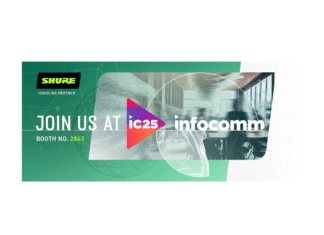AtlasIED Improves Their Atmosphere – Firmware Version 2
AtlasIED Improves Their Atmosphere – Firmware Version 2.0
In the spring of 2021, I was asked to evaluate firmware version 2.0 for AtlasIED’s Atmosphere DSP engine. AVNation was involved in the launch of the new digital audio platform. Knowing many of the people involved in creating a new ecosystem that combines digital audio processors, amplifiers, graphical user interfaces, programming software with touchless control and AI I was intrigued.
I have been loaned a small Atmosphere system to work. I have previously supplied comments to the AtlasIED team about the features that were great, and some missing features that could improve the use and applications of the platform. When version 2.0 of the firmware was being developed, I was given a preview of the software and saw that many of the comments I had made were implemented as well as other additions that other parties have suggested.. Now that it has been released publicly, I can release my finding publicly. This review is going to focus on the Atmosphere AZM8 signal processor and its accessories that all have been given new firmware. The Atmosphere system exposes its technology where it is appropriate but also hides some of the options from end users. This allows for a user to concentrate on the project and not the technology being used to create it. It allows for the focus to be on the tasks, not how to do the tasks. It also uses networking for control, but not for audio transport which is a key point.
The Basics
This product is designed for the commercial audio market. The end user will typically be non-technical, the interfaces have been designed to work with their needs. One can easily use this product family in schools, restaurants, retails, and business environments. It has a good robust feature set for those markets. The DSP engine has ten mono summed inputs on the unit, with the ability to add up to four expansion inputs through accessories. These external inputs are summed to mono as well. Under the new firmware it is possible to treat the internal inputs as stereo pairs; how inputs are ganged is at the integrator’s discretion. There are eight mono outputs on the unit, with no expansion options through the accessories. The same ganging of controls can be done to create stereo pairs or stereo with subwoofer.
Again, it’s important to note that this product is designed for the commercial market. The hardware is not designed to do everything. It is designed to work in the commercial market well. It has a feature set aimed for this market and its segments. It works well in a restaurant, but it might not be the right solution for a restaurant in a stadium that is part of a larger network (although could be integrated as such for specialty uses). The Atmosphere product is a good solution for the K-12 education markets and manufacturing environments. I know that this sounds strange at first, but the importance of tones or bells to indicate the start and stop of periods is important for both. The ability to zone the bells to specific areas allows for the separation of bells by grades or production lines.
The 2.0 Updates
The addition of room combining in firmware version 2.0 for the Atmosphere DSP has enhanced its functionality for the hospitality markets. For restaurants, bars, and ballrooms the ability to easily adapt to the current needs or configurations is important. Through the use of the General-Purpose Input and Outputs (GPIO) on the unit, it is possible for the integrator to define how the system reacts to airwalls or dividers being used. This ability improves the end-user’s experience by removing one more task from their processes. For a simple presentation space with a laptop and projector, being able to connect via Bluetooth™ using the Remote Bluetooth Audio Input (A-BT) accessory to the audio system offers ease of connection while reducing the trip hazard. One could also use the RCA/3.5MM Audio Input(A-RCA) to use a wired connection. If a more complex connection is needed, it is still possible to install an input panel that is wired to the Mic/Line inputs of the Atmosphere DSP.
The stereo and subwoofer features that have been added through firmware version 2.0 works well. It does require that the person configuring the system set the stereo pairs and use during the input definition, not during the output process. It works as one would expect to have the system provide a seamless routing of the stereo signal through the system. AtlasIED did a good job reacting to the requests from the marketplace through the changes to the firmware and software interface it is important to remember that no changes have been made to the hardware. This approach has been used by other companies for decades, the first time I remember seeing it was in the later 1990’s when crossovers were available as 2×2 or 1×4 the only difference being the interface. It is a practical solution to the request.
The Atmosphere system does not require the use of specific software. It is configured through a web browser; it immediately becomes compatible with any graphical operating system which is nice. The manual does a good job of pointing out that Safari and Chrome are the preferred browsers. The unit has multiple ways to connect, there is an Ethernet connection via a hardwired RJ-45 as well as two Wi-Fi options, join an existing network or become a standalone network. In both cases the IP address is displayed on the front display. I recommend using a hardwired connection for firmware updates. When the firmware is done being updated the unit reboots, which causes the network to disconnect and at times the computer does not auto reconnect based on user settings. Also loading audio files is much faster via wired connections. It is advisable to set a static address for the unit as this will make some of the features much easier to use. The practice of using static IP addresses for ease of control is not limited to Atmosphere products it is helpful for many products.
The GUI and Navigation
Navigating through the interface is intuitive, one simply starts at the top left and works through to the lower right making selections as needed. The system does have a fixed architecture but routing paths through the DSP is adjustable. Some people refer to the approach used as Tic-Tac-Toe style. A key thing to be mindful of is that there is no offline mode or working disconnected from the unit. Changes are made in real time. If you are not careful you can send high level signal into your system and scare yourself; don’t ask me how I know, I just know. IFKYK
After working through the software, I found outlining the paths and rules ahead will save both time and frustration. The proliferation of open or drag and drop architecture in DSP has caused a certain amount of final routing be configured in the field. That is possible to do with fixed architecture, however the speed gained by defining inputs, outputs, routing, and priority levels speeds up the process quite a bit.
The Many Accessories
A feature that sets Atmosphere apart from other commercial processors is the ability to extend functionality through external accessories. Typically, the accessories in this price range are control interfaces only. Atmosphere has three different categories of accessories: control, monitoring, and audio input. These accessories range from Bluetooth interfaces to Ambient Noise Sensors to Volume Controls. These devices are the connective items that make the solution user friendly. Many of the interfaces are available in other user’s products but not as easily. That is not to say that these are perfect, there are some limitations to the products that must be considered. There is a limit of one audio device, “A Series”, accessory per accessory chain. Working through use cases the restriction did cause some design changes. I had configured a restaurant with a meeting room. They would want to have both an XLR input and a line level RCA/3.5mm input panel. That would be two on a single accessory loop if they were wired serially. If one were to run a home run to each panel the system would function. It is a limitation, but not an impediment.
The Easy Ambient Noise Sensing Technology
The Ambient Noise Sensor (X-ANS) accessory is one of the easiest ambient noise sensors I have used. The ability to allow the unit to do an auto adjustment as a quick start is very useful. Typically, there is more setup needed by setting the target, the threshold, the range of impact, attack and release time… etc. This one I simply turned on the “Auto Mode” and the unit determined the target level based on the adjustments I made to the zone level control. I used a self-powered speaker to playback restaurant ambience in my lab. After about ten minutes of making changes to the ambiance and adjusting the output level of the zone I was testing I could see the Atmosphere starting to make predictions. This system learning can only be done with acoustic energy in the room, in other words one cannot just send a signal into an input to hopefully simulate the experience. On a side note, if you have not taken a look at mynoise.net, it is a great tool to use for setting up various audio systems as it allows one to create the ambience of the space even if people aren’t there. I have used it to setup noise masking systems as well with good success.
The connection of the remote accessories was easy and quick using Category 5E or better cable and 8P8C connectors (the male RJ-45 connector). The warning in the manual of not using premade cables when trying to install panels in electrical boxes was one, I had not seen before. After trying it, the recommendation is based on the size of the strain relief boot on most premade cables. Pointing out that fact is something most manufacturers do not do, and it is something to be heeded. I tried and it would not work as they indicated. There are other things that are done to make the process smoother than other products. Using the same size removable barrier block, also known as Euro block or Phoenix Connector, for all the AZM including the general-purpose input output (GPIO) allowed for less tool changes.
The Controllers
There is a control accessory that sets itself apart for me. The Atmosphere AZM products have a web server in it that also serves up control interfaces via webpages with no coding required. The pages are designed to work on mobile or handheld devices but also functions well on other size displays. Not only can these web pages automatically mirror the wall controllers, one can also easily create unique virtual controllers easily in the software. The integration that this feature enables cannot be overlooked. This allows the system to be controlled from many point-of-sale solutions in restaurant and retail spaces using browser-based interfaces. Now instead of having to worry about the accessibility to controls in dining areas in a restaurant, the controls can be placed into the point of sale. Below are some examples I quickly created using the web interface of the Atmosphere. The control interfaces basically create themselves based on the configuration of the hardware.
The zone selector and virtual controllers can have access restricted by using a four-digit code. If more security is desired, it can be deployed through the IT infrastructure. Using some basic settings in a router I was able to make it so that AZM was only available through a hardwire connection and only through certain devices by MAC address filtering. This level of access is not unique to AtlasIED, but it is something to be aware of with how easily one can control the entire system from web browsers and not use wall controllers at all.
The Message Playback
Having one gigabyte of storage available for message playback is a unique feature in this market. As I was contemplating use cases, the benefits started to become visible. For a bar, have a prerecorded message that is scheduled to indicate last call takes the burden off the staff and makes sure it is played each day. Adding in that it can be triggered manually allows the staff to still play the message when closing early. For schools the ability to play the “fight song” directly from the Atmosphere avoids the challenges of not having a copy of it available.
There are also things that are personal preference. Within the equalizer pages I would like to be able to see all the filter frequencies at once, not solely as a graph but values. I also wonder if the use of Q instead of octaves for filter width will confuse some users. I do like the automatic or self-heal feature for the accessories. During testing in my lab, I could replace and move accessories without an issue and the system just worked. The idea of being able to just send a wall controller to a customer and have them replace it as it is just connecting an RJ45 to an 8P8C can be a huge cost and frustration saver.
Comparisons
| Feature | AtlasIED Atmosphere |
dbx ZonePro 1260 |
Symetrix Zonemix 761 |
QS MP-M80 |
| Inputs | 10 plus accessory input for a total of 14 |
12 | 12 | 16 |
| Outputs | 8 | 6 | 6 | 8 |
| Configuration | Browser Safari or Chrome |
Software for Windows | Software for Windows | Software for iOS/Android tablets, Windows and Mac OS |
| Features (from product website) |
4 accessory ports App-less web based virtual wall controller Bell Scheduler Integrated message player Room combine and groups Mono, stereo, and subwoofer support Auto noise compensation On board WIFI Large library of AtlasIED speaker presets Accessory self-heal High Priority GPI input Wide selection of audio DSP objects |
Advanced Feedback Suppression (AFS™) Autowarmth® Auto Gain Control Compression Limiting Noise Gating Notch Filtering Bandpass and Crossover Filters Parametric EQ Security Lockout Wall Panel Control RS-232 Control |
Input and Output Gain Highpass Filtering Parametric Equalization Compression Limiting Automatic Gain Control Ducking Feedback Elimination Signal Routing Delay Polarity |
EQ Dynamics 1/3 octave GEQ Anti-feedback Filters Dynamics Delay Loudspeaker tunings Effects |
| MSRP | $1499.99 | $869.00 | $1958.00 | $1,670.00 |
| Computer Based Controllers |
Yes, define in software | No | Need ARC software | MP Install or MP Manager Software needed |
| Configuratio Tool |
Browser | Windows Software | Windows Software | Windows Software |
Overall, the Atmosphere platform is a system I would recommend considering for projects. The product is well designed for the commercial market and will easily meet typical needs. The main features that make me consider this product over some of the others are message playback, easy ambient noise compensation, the web-based control panels, and the zoning system. The available accessories, such as Ambient Noise Sensors, are the items that turn this product from a signal processor into a system solution.
Bradford Benn is the founder of Advisist Group, LLC as well as being a member of the AVNationEditorial Advisory Board and Director Ermirtus of AVNation.You can find out more about him on LinkedIn or at the Advisist website.
 العربية
العربية 简体中文
简体中文 Nederlands
Nederlands English
English Français
Français Deutsch
Deutsch Italiano
Italiano Português
Português Русский
Русский Español
Español











